Testing the Resilience of the European Healthcare Sector

To ensure citizens’ trust in the medical services and infrastructure available to them, health services should function at all times. If health services and infrastructures in Europe were the object of a major cyber attack, how would we respond and coordinate at both national and EU level to mitigate the incidents and prevent an escalation?
This is the question Cyber Europe 2022 sought to answer using a fictitious scenario. Day one featured a disinformation campaign of manipulated laboratory results and a cyber attack targeting European hospital networks. On day two, the scenario escalated into an EU-wide cyber crisis with the imminent threat of personal medical data being released and another campaign designed to discredit a medical implantable device with a claim on vulnerability.
The Executive Director of the EU Agency for Cybersecurity, Juhan Lepassaar, said: “The complexity of our challenges is now proportionate to the complexity of our connected world. This is why I strongly believe we need to gather all the intelligence we have in the EU to share our expertise and knowledge. Strengthening our cybersecurity resilience is the only way forward if we want to protect our health services and infrastructures and ultimately the health of all EU citizens.”
The pan-European exercise organised by ENISA rallied a total of 29 countries from both the European Union and the European Free Trade Association (EFTA), as well as the EU agencies and institutions, including ENISA, the European Commission, the CERT of EU Institutions, bodies and agencies (CERT-EU), Europol and the European Medicine Agency (EMA). More than 800 cybersecurity experts were in action to monitor the availability and integrity of the systems over the two days of this latest edition of Cyber Europe.
Can we strengthen the cyber resilience of the EU healthcare?
The participants who engaged in the complex exercise were satisfied with the way the incidents were dealt with and the response to fictitious attacks.
Now, the analysis of the process and of the outcomes of the different aspects of the exercises need to be performed in order to get a realistic understanding of potential gaps or weaknesses which may require mitigation measures. Dealing with such attacks requires different levels of competences and processes which include efficient and coordinated information exchange, the sharing of knowledge around specific incidents and how to monitor a situation which is about to escalate in case of a generalised attack. The role of the EU level CSIRTs network and the draft standard operation processes (SOPs) of the CyCLONe group also need to be looked into.
The deeper analysis will be published in the after-action report. The findings will serve as a basis for future guidance and further enhancements to reinforce the resilience of the healthcare sector against cyber attacks in the EU.

